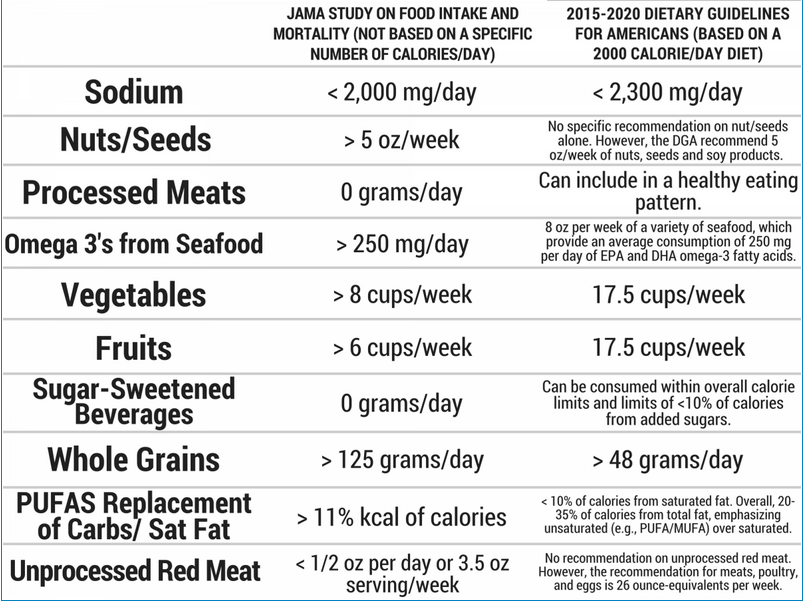Your Location:Home - News Updates > - Content
News and Information
Fast Take: A Recent Study in JAMA vs. the Dietary Guidelines
Time:2017-03-10 13:46:39
Source:IFIC

Hardly a month goes by without a new nutrition research study capturing headlines. March is National Nutrition Month, so, of course, another nutrition study (Micha et al.) is in the spotlight.it is published in the Journal of the American Medical Association (JAMA) and examines the associations between intakes of specific foods and nutrients on cardiometabolic health outcomes including heart disease, stroke, or type 2 diabetes. In addition, these findings are making waves because the paper and certain media outlets are including recommendations on specific amounts and proposing that some foods be eliminated from the diet completely. We address that clearly below, but-spoiler alert-the recommendations and guidelines presented in the JAMA study are not aligned with other expert guidelines.
Luckily for us, recommendations for how these foods can be a part of a healthy eating pattern already exist in the form of the 2015-2020 dietary Guidelines for Americans (DGAs). Since we are food nerds and are all about digging into the science weeds, we thought we would take this Fast Take one step further and also compare how the JAMA study findings compare with DGA recommendations.
First things first. The study estimated the association between the intake of 10 specific foods and cardiometabolic mortality. These foods included fruits, vegetables, nuts/seeds, whole grains, unprocessed red meats, processed meats, sugar-sweetened beverages(SSBs), polyunsaturated fats, seafood omega-3 fats, and sodium. The study’s authors used risk assessment model, taking data from two National Health and Nutrition Examination Surveys (1999-2002 and 2009-2012) with over 16,000 respondents to establish and link specific foods and eating styles with cardiometabolic-associated deaths in 2012.
As with every scientific study this research also have some significant limitations. For example,
The authors states that their finds did not “ not prove that changes in this dietary habits reduce disease risk.” Additionally, in an accompanying editorial to this research, Noel T. Mueller, PhD, and Lawrence J. Appel, MD, urge that “several aspects of the study methods and findings require careful evaluation.”
But media conversation surrounding the study hasn’t been quite so careful. Some of the coverage has gone so far as to state that some of the foods included in the study do not have a place (like, at all) in our diets. Last time we checked, we rely on large bodies of research (not single studies) and guidelines such as the DFAs to support these types of statements.
Because of this, we thought it would be interesting to directly compare recommendations stemming from the JAMA study (which are based on mortality risk) to recommendations from the DGAs ( which provide guidance for choosing a healthy diet and focus on preventing the diet-related chronic diseases).
It should be pretty easy for you to see where the differences are and how you should regard the recommendations from a single study versus the recommendations from a large body of evidence.
Luckily for us, recommendations for how these foods can be a part of a healthy eating pattern already exist in the form of the 2015-2020 dietary Guidelines for Americans (DGAs). Since we are food nerds and are all about digging into the science weeds, we thought we would take this Fast Take one step further and also compare how the JAMA study findings compare with DGA recommendations.
First things first. The study estimated the association between the intake of 10 specific foods and cardiometabolic mortality. These foods included fruits, vegetables, nuts/seeds, whole grains, unprocessed red meats, processed meats, sugar-sweetened beverages(SSBs), polyunsaturated fats, seafood omega-3 fats, and sodium. The study’s authors used risk assessment model, taking data from two National Health and Nutrition Examination Surveys (1999-2002 and 2009-2012) with over 16,000 respondents to establish and link specific foods and eating styles with cardiometabolic-associated deaths in 2012.
As with every scientific study this research also have some significant limitations. For example,
The authors states that their finds did not “ not prove that changes in this dietary habits reduce disease risk.” Additionally, in an accompanying editorial to this research, Noel T. Mueller, PhD, and Lawrence J. Appel, MD, urge that “several aspects of the study methods and findings require careful evaluation.”
But media conversation surrounding the study hasn’t been quite so careful. Some of the coverage has gone so far as to state that some of the foods included in the study do not have a place (like, at all) in our diets. Last time we checked, we rely on large bodies of research (not single studies) and guidelines such as the DFAs to support these types of statements.
Because of this, we thought it would be interesting to directly compare recommendations stemming from the JAMA study (which are based on mortality risk) to recommendations from the DGAs ( which provide guidance for choosing a healthy diet and focus on preventing the diet-related chronic diseases).
It should be pretty easy for you to see where the differences are and how you should regard the recommendations from a single study versus the recommendations from a large body of evidence.

So in case this study has got your feathers all ruffled about what foods you should eat and what foods you should avoid, focus instead on establishing a healthy dietary pattern that works for you and your preferences. This includes a dietary pattern that is higher in vegetables, fruits whole grains, low-or-non fats dietary, seafood, legumes, and nuts, moderate in alcohol ( If you are an adult who chooses to drink); lower in red and processed meat; and low in sugar-sweetened foods/drinks and refined grains.




